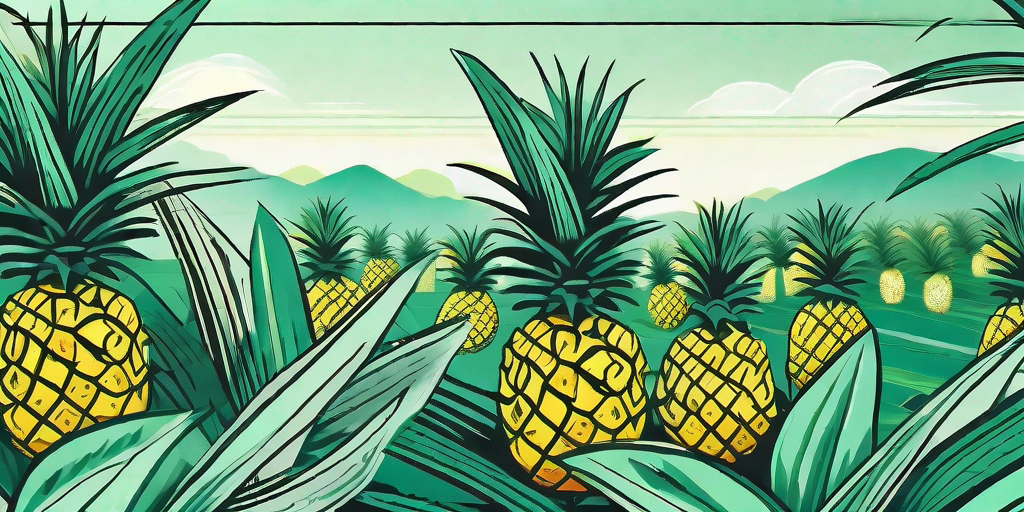
Welcome to the tropical world of pineapple picking! If you've ever dreamed of plucking your own sweet, juicy fruit straight from the plant, you're in the right place. This guide will take you through the process, from identifying the ripest fruit to the actual picking, and even some bonus tips on how to enjoy your harvest. So, put on your sun hat, grab your gardening gloves, and let's dive in!
Understanding the Pineapple Plant
The Basics
Before we get into the nitty-gritty of pineapple picking, it's important to understand the plant itself. The pineapple (Ananas comosus) is a tropical plant with an edible fruit. It's a bromeliad, which means it's in the same family as Spanish moss and air plants. But unlike its relatives, the pineapple plant produces a sweet, succulent fruit that's loved worldwide.
Each pineapple plant grows out of the ground from a small seedling and matures into a large, bushy plant. It has long, spiky leaves that can reach up to 5 feet in length. The fruit itself grows in the center of the plant, surrounded by these leaves.
The Life Cycle
The pineapple plant has a fascinating life cycle. It takes about 18-24 months for a plant to produce its first fruit. After that, it can continue to produce fruit for up to 50 years! However, each plant only produces one fruit at a time. Once a fruit is harvested, the plant will start the process all over again, producing a new fruit.
Interestingly, the pineapple plant is a monocarpic plant, which means it dies after producing fruit. But don't worry, it leaves behind offshoots, or "pups", that grow into new plants and continue the cycle.
Identifying a Ripe Pineapple
Color
One of the easiest ways to identify a ripe pineapple is by its color. A ripe pineapple will have a golden yellow color. However, don't be fooled by the green ones. They can be ripe too! The key is to look for a uniform color, whether it's green or yellow.
Remember, a pineapple that's too green might not be ripe yet, and one that's too yellow might be overripe. So, aim for that sweet spot in the middle.
Smell
Another great way to check for ripeness is by smell. A ripe pineapple will have a sweet, tropical smell. If it doesn't smell like anything, it's probably not ripe yet. And if it has a vinegary or fermented smell, it's likely overripe.
So, don't be shy! Give that pineapple a good sniff. Just make sure no one's watching, or they might think you're a little fruity!
How to Pick a Pineapple
Step 1: Choose Your Pineapple
Now that you know how to identify a ripe pineapple, it's time to choose your fruit. Look for a pineapple with firm, golden skin, and a sweet smell. The leaves should be green and healthy-looking, not brown or wilted.
Remember, the perfect pineapple is out there, waiting for you. So, don't settle for less!
Step 2: Twist and Pull
Once you've chosen your pineapple, it's time to pick it. The best way to do this is by using the twist and pull method. Simply grasp the fruit firmly, twist it slightly, and then pull it off the plant.
Be careful not to pull too hard, or you might damage the plant. And watch out for those spiky leaves. They can be a real pain in the... hand!
Enjoying Your Harvest
Storing Your Pineapple
After you've picked your pineapple, you'll want to store it properly to keep it fresh. The best way to do this is by keeping it at room temperature. This will allow the pineapple to continue ripening.
If you want to keep it longer, you can refrigerate it. Just make sure to eat it within a few days, or it might start to lose its flavor.
Preparing Your Pineapple
Preparing a pineapple can be a bit tricky, but with a little practice, you'll be a pro in no time. Start by cutting off the top and bottom of the pineapple. Then, stand it up and slice off the skin, following the curve of the fruit.
Once the skin is removed, you can cut the pineapple into slices or chunks, depending on your preference. Just make sure to remove the core, as it's tough and not very tasty.
Frequently Asked Questions
Can I grow a pineapple from a store-bought fruit?
Absolutely! In fact, it's a fun and easy way to grow your own pineapple plant. Simply cut off the top of the fruit, let it dry for a few days, and then plant it in a pot with well-draining soil. With a little patience and care, you'll have a new pineapple plant in no time!
Why is my pineapple plant not producing fruit?
There could be several reasons for this. It could be that the plant is not mature enough yet, as it takes about 18-24 months for a pineapple plant to produce its first fruit. It could also be due to insufficient light or nutrients. Make sure your plant is getting plenty of sunlight and is well-fed with a balanced fertilizer.
Conclusion
There you have it, a comprehensive guide to pineapple picking. With these tips and tricks, you'll be harvesting your own sweet, juicy pineapples in no time. So, what are you waiting for? Get out there and start picking!
And remember, the best part about pineapple picking is getting to enjoy the fruits of your labor. So, don't forget to sit back, relax, and savor every bite of your homegrown tropical treat. Happy picking!











